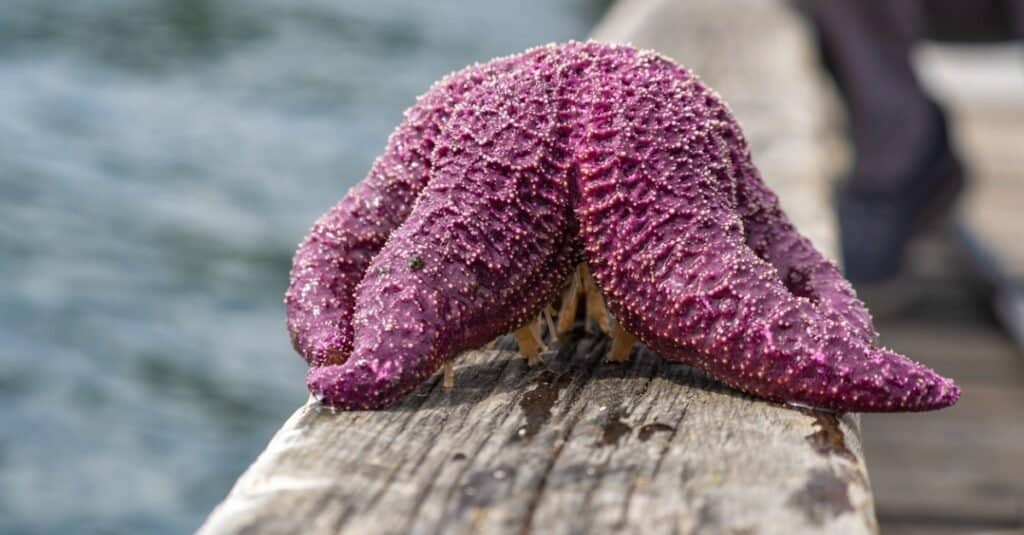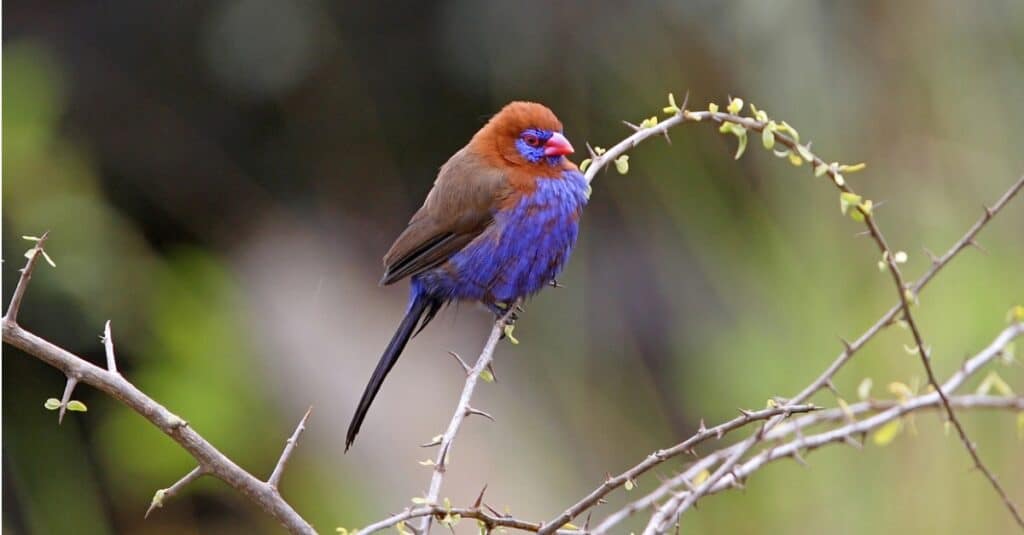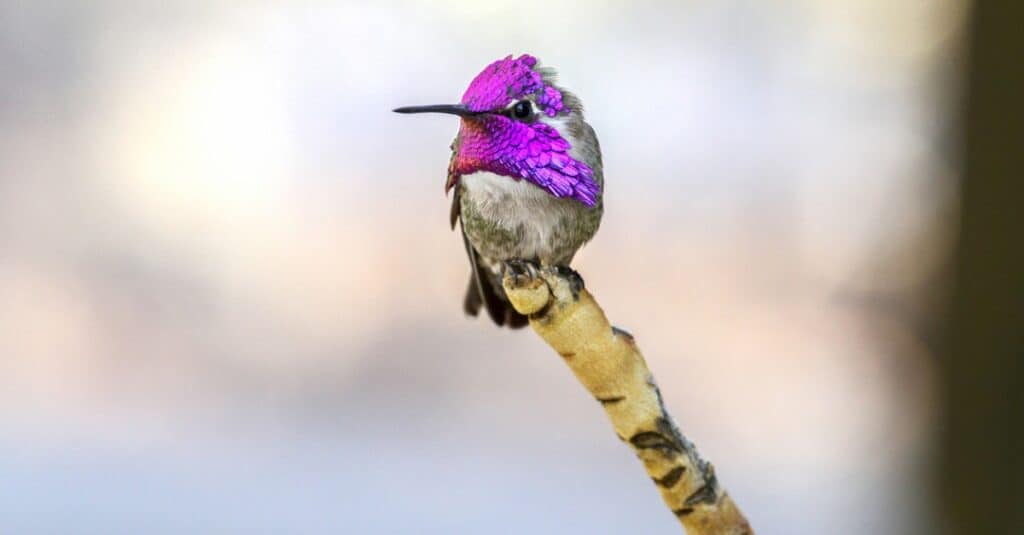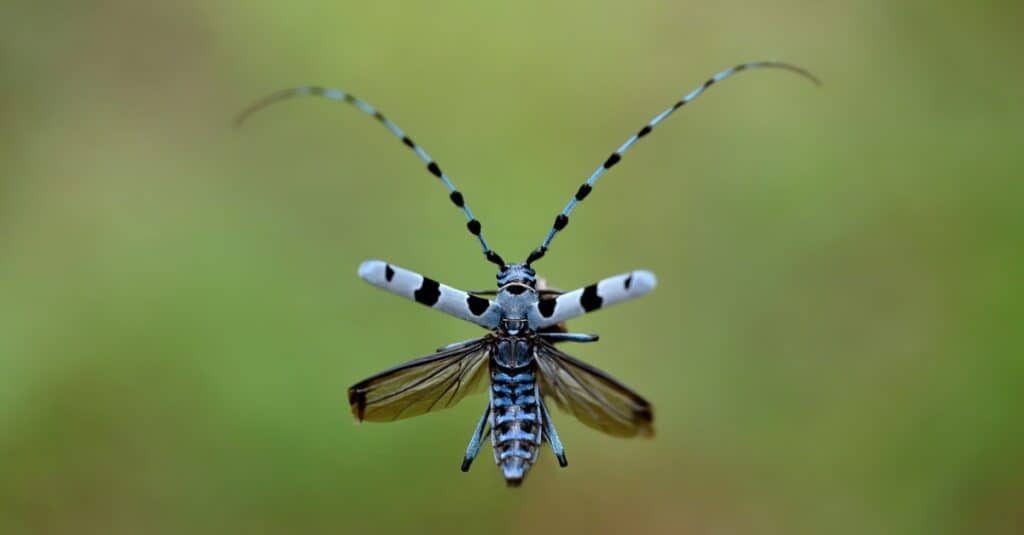Color plays an integral role in the animal kingdom. Though purple animals are rare, there are many shades of purple that arise in both animals and plants around the world.
Naturally, purple animals are hard to come by because mammals can’t create that pigment. Even the birds and insects that feature different shades of purple only do so as the result of structural coloration.
Different shades of purple exist in animals as a way to get attention. Some of that attention is to attract pollinators, while others use it as a warning to stay away. Within the species, the bright violet hue can also help to attract a mate. Let’s take a look at some of the rare purple animals that naturally exist.
1. Violet-Backed Starling

©iStock.com/Michael Fitzsimmons
The violet-backed starling offers metallic shades of purple across their feathers, though this shade is often seen on the male. It is used as a way to attract a female, which is mostly brown with some flecks of neutral tones. Since they have no violet in their feathers, females often stay hidden from predators rather easily.
The Violet-Backed Starling is a sexually dimorphic species, they can reach a length of about 7 inches and are a stunning violent color. The female is mostly brown, however, the males are vibrant like in many other species of birds. These incredibly eye-catching bird are typically found in woodland or grassland areas in Africa.
To find the violet-backed starling, you’d have to travel to sub-Saharan Africa.
2. Purple Starfish

©iStock.com/Dale Gu
The purple starfish is a sight to behold, found deep in the water. Animals that reside a couple of meters below the surface often are hidden by the lack of light. Purple is the easiest to see from a certain depth, unlike red and orange that disappear about 15 meters below the surface.
The only color that can be seen quite as easily is blue, which can be seen 60 meters below. These naturally purple animals want to be seen. However, their use of violet isn’t meant to attract a mate. Instead, it warns predators to stay away.
3. Indian Purple Frog
The easiest place to find the Indian purple frog is in the Western Ghats of India. At six to nine cm long, these frogs aren’t known for being poisonous, though that is often the assumption for their deep shades of purple and gray. They aren’t even dangerous; locals have been eating them for over a century and they boast incredible medical benefits.
The purple frog has a large, bloated body with shirt limbs. It is as mentioned, dark purple to greyish in color. This frog can reach about seven centimeters long and has a small head in comparison to it’s body and other frog species. In addition to a small head, it also possesses an usually pointed snout. It’s short forelimbs have hard palms to aid it in burrowing underground.
Most of their lives are spent underground, mostly eating termites in the rainforest.
4. Violet-Crowned Woodnymph

©iStock.com/neil bowman
The violet crowned woodnymph is part of the hummingbird family, often found in subtropical or tropical habitats. At 10.2cm long, the adult features a violet crown that matches its upper back, shoulders, and belly. The female, however, is bright green instead.
It is however, closely related to the Mexican Woodnymph (Thalurania ridgwayi) and Green-Crowned Woodnymph are usually lumped together as the Crowned Woodnympth. Although they are usually placed together in a group, they are considered different species.
Often the shades of purple or green don’t fully develop until the bird is older.
5. Purple Grenadier

©iStock.com/neil bowman
The purple grenadier is a type of finch that typically lives in eastern Africa. They have purple feathers for their entire life, rather than later developing the color like the violet-crowned woodnymph. The males usually have more color, attracting females when it is time to mate.
The combination of colors – chestnut brown and a muted violet – makes these rare purple animals quite a sight to see.
6. Costa’s Hummingbird

©iStock.com/Monica Lara
Costa’s hummingbird is the second purple hummingbird found on this list. These naturally purple animals follow the same pattern as other birds, only displaying purple in the male’s feathers with shades of white and green as well. The purple makes them easy to spot by females during mating.
They are easy to spot in the Sonoran and Mojave Deserts, but a sugar-water feeder may make them easier to attract.
7. Magnificent Sea Anemone

©Ethan Daniels/Shutterstock.com
Magnificent sea anemones are rare purple animals found in the Indo-Pacific region of the world. Though the flared oral disc and the tentacles tend to be light beige or white, the column is where the true beauty is. Though many images have been recorded with purple columns, they also can be found in blue, green, red, or pink.
Rather than warning predators, the color primarily depends on the algae around them.
8. Glutinous Snail
The glutinous snail is a freshwater snail that is both beautiful and incredibly delicate. Though the snail itself is practically translucent, the shell features a beautiful purple hue. Since purple is such a rare natural color, people in Ancient Rome used to source their dye from snails. To make it, the dye-maker had to crack open their shell to get the mucus before exposing it to the sun. To even get an ounce of dye, up to 250,000 could’ve been required, but the effect is long-lasting.
9. Spanish Shawl

©worldswildlifewonders/Shutterstock.com
The Spanish shawl, a sea slug, is vibrant with both violet and orange to decorate its body. Typically, they are found on the west coast of the United States, Canada, Mexico, and the Galapagos Islands. The colors of their body all come from a carotenoid pigment called astaxanthin.
The reason for their colors is two-fold. While the orange gills help them to camouflage while eating prey, the brightness of their entire body tells predators to stay away. It is an indication that they either taste bad or are poisonous to the predator.
10. Longhorn Beetle

©iStock.com/JMrocek
The longhorn beetle is more of a greyish purple than a vibrant color like other rare purple animals on this list. Also known as longcorns, these beetles are an invasive species, invading homes. Though most people see them as a nuisance, they aren’t harmful to anything. They won’t damage the structure or furniture of a home, and there’s no way for them to bite or sting. Instead, the purple hue seems to primarily be due to exposure to different lighting, sometimes turning blue as well.
List of Rare Purple Animals
Here is a summarized list of 10 rare purple animals in the world:
| Rank | Animals |
|---|---|
| 10. | Violet-Backed Starling |
| 9. | Purple Starfish |
| 8. | Indian Purple Frog |
| 7. | Violet-Crowned Woodnymph |
| 6. | Purple Grenadier |
| 5. | Costa’s Hummingbird |
| 4. | Magnificent Sea Anemone |
| 3. | Glutinous Snail |
| 2. | Spanish Shawl |
| 1. | Longhorn Beetle |
Next Up…
- Cute Snails – Didn’t think snails could be huge? Although slimy, you would be surprised how cute some of these snail species actually are!
- Pond Snail vs Bladder Snail: What are the Differences? – Find out some of these key differences between these often confused species of snail!
- Pet Snails: How To Keep Snails Healthy & Happy – Interested in owning a snail as a pet? Learn how to keep them happy and thriving!
The photo featured at the top of this post is © iStock.com/Monica Lara
Thank you for reading! Have some feedback for us? Contact the AZ Animals editorial team.







